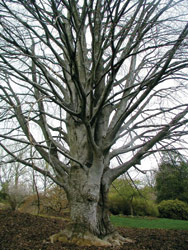One of my favorite destinations, regardless of the time of year, is a venerable chestnut oak—at least 200 years old—that sits on a steep slope right on my property line. The fact that it’s a boundary tree on a very steep slope is the only reason it’s still with us today. Had it been almost anywhere else on the property, it would long ago have become beams in someone’s tobacco barn or, worse, firewood.

With its enormous trunk and deeply fissured bark, the oak is truly imposing. Its wide-spreading, massive branches are a visual feast, especially during the six months when the tree is leafless. The irregularity of its structure, bent by the vagaries of centuries of weather, is truly a work of art.
It may be clichéd to call a flower a work of art, but if anything in the plant world deserves such high praise, it is certainly mature trees. They possess a special majesty that uplifts and humbles as few things in Nature can. In a culture that emphasizes the facile and ephemeral—where the Britney Spearses of this world garner so much unwarranted attention—it’s a blessing to have access to true grandeur.
And as more and more land is developed and mature trees in older neighborhoods decline and die, it’s important to plant specimen trees for generations yet unborn. Today, people live in a house for only five years, on average. So the temptation is to invest in something that will give instant gratification. Most of us don’t think about planting something that won’t reach its zenith till after we’re dead. But just think what our cities and older neighborhoods would look like if prior generations had planted nothing but shrubs and fast-growing trees.
Mature trees provide more ambiance and a stronger sense of place than any other single element in the environment. This is particularly true for certain species. Unfortunately, most of them are slow-growers that measure time in centuries rather than decades. Nursery owners both create and respond to demand, but in general, tree species or varieties that are easy to propagate, fast-growing and readily transplantable tend to become dominant in the marketplace.
Thus, basic economics relegates many worthy trees to the back burner. They’re infrequently planted, even though they may be superior in the long run. Consumers buy what’s available, and that typically means only what nurseries can grow simply and profitably. As a result, almost every new yard and parking lot has a ‘Red Sunset’ or ‘October Glory’ red maple. Don’t get me wrong—they’re wonderful trees, and their autumn color is hard to beat. But what about the true aristocrats that are ignored?
As with most things in this world, there are some standouts that are truly the crème de la crème. Here are a few that I wouldn’t be without: white oak, American and European beech, Katsura tree, ginkgo, Nordman fir, shagbark hickory, Atlas cedar and American yellowwood. Any such list is subjective, of course, but all of these will last many human lifetimes, providing centuries of enrichment. Simply by planting one of these remarkable trees, we ordinary folk can accomplish a good that will resonate for hundreds of years. How often can we hope to achieve something so far-reaching?
Naturally, royalty demands special consideration, and all of these noble trees require careful siting. They need to be planted where they can reach their fullest expression, so give them room—they will eventually grow quite tall and have a considerable spread, and their character and effectiveness will be greatly diminished if they’re cramped. Above all, don’t plant them under a power line. And if your own lot is too small, talk to your neighbors and try to find a suitable place in your neighborhood, even if it means sharing your tree with an adjoining lot.
If you’re a member of a country club, school, community or development group, talk to the pertinent committee or developer about planting some of these special trees for the future. This is one of the few areas where we can use our influence to help shape the character of our communities. Do it, and your contribution will be enjoyed for generations to come.


Before you comment
The comments section is here to provide a platform for civil dialogue on the issues we face together as a local community. Xpress is committed to offering this platform for all voices, but when the tone of the discussion gets nasty or strays off topic, we believe many people choose not to participate. Xpress editors are determined to moderate comments to ensure a constructive interchange is maintained. All comments judged not to be in keeping with the spirit of civil discourse will be removed and repeat violators will be banned. See here for our terms of service. Thank you for being part of this effort to promote respectful discussion.